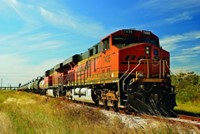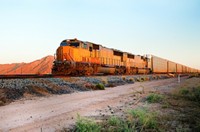Advertisement
Grab your lab coat. Let's get started
Welcome!
Welcome!
Create an account below to get 6 C&EN articles per month, receive newsletters and more - all free.
It seems this is your first time logging in online. Please enter the following information to continue.
As an ACS member you automatically get access to this site. All we need is few more details to create your reading experience.
Not you? Sign in with a different account.
Not you? Sign in with a different account.
ERROR 1
ERROR 1
ERROR 2
ERROR 2
ERROR 2
ERROR 2
ERROR 2
Password and Confirm password must match.
If you have an ACS member number, please enter it here so we can link this account to your membership. (optional)
ERROR 2
ACS values your privacy. By submitting your information, you are gaining access to C&EN and subscribing to our weekly newsletter. We use the information you provide to make your reading experience better, and we will never sell your data to third party members.
Safety
Rail Safety Upgrade Raises Rate Concerns
Railroads want firms that ship toxic chemicals to absorb the cost of new technology
by Glenn Hess
September 24, 2012
| A version of this story appeared in
Volume 90, Issue 39

The Obama Administration has agreed to scale back new safety rules requiring crash avoidance technology for passenger trains and freight rail lines that haul highly toxic materials, as mandated by a 2008 law. The change reduces by 14% the number of route miles that will need to be modified to install the technology. But the chemical industry remains concerned that it will get stuck paying the bill for deployment of the multi-billion-dollar, high-tech systems known collectively as positive train control (PTC).
Shipping rates for tank cars of chlorine, anhydrous ammonia, and other extremely hazardous chemical cargo would more than double if railroads pass on to manufacturers the full cost of implementing the congressionally mandated safety upgrades, say officials of the American Chemistry Council (ACC), an industry trade association.
“Our concern is that because PTC is required on lines that carry products such as chlorine, the regulations could potentially impact our ability to ship these essential products where they are needed,” says Jeffrey Sloan, senior director of ACC’s Chlorine Chemistry Division. “We want to make sure PTC is implemented in a way that recognizes the potential commercial impact on shippers and receivers of these products.”
The integrated technologies are designed to override human error and automatically control train movements to prevent head-on collisions or derailments that can result from excessive speeds. PTC can also protect maintenance workers along tracks by slowing or stopping trains entering work zones.
Conventional safety systems use trackside equipment to determine train location within a block of track and a colored-light notification system for engineers. PTC combines digital communication systems, Global Positioning System technology, and onboard computers with track databases to continually monitor train location and speed. PTC is integrated with railroad dispatching systems to manage train traffic.
The Rail Safety Improvement Act, which President George W. Bush signed into law in October 2008, mandates that railroads install PTC systems nationwide by the end of 2015 on lines used to transport passengers or “toxic by inhalation” materials—gases or liquids that are especially hazardous if released into the atmosphere.
Congress passed the legislation shortly after a deadly train wreck in Chatsworth, Calif. On Sept. 12, 2008, a Metrolink commuter train collided with a Union Pacific locomotive, killing 25 people and injuring 135 others. The crash was the worst U.S. train accident in 15 years. Federal investigators found that the Metrolink driver was sending and receiving text messages just before his commuter train skipped a red light and slammed into the locomotive.
The National Transportation Safety Board has said that PTC would have prevented the train collision in Chatsworth, as well as a January 2005 rail crash in Graniteville, S.C., that killed nine people and injured at least 250. That crash punctured a chlorine tank car, releasing a toxic cloud that led to the evacuation of about 5,400 residents.
In a final rule issued in January 2010, the Federal Railroad Administration estimated that it would cost railroads up to $13 billion over 20 years to install and maintain PTC technology on about 70,000 miles of track. After the freight rail industry complained that the original mandate for PTC installation was based on outdated hazmat traffic data, the railroad administration revised the regulations earlier this summer.
Under the new rule, which took effect in mid-July, the crash avoidance technology will not be required on an estimated 10,000 miles of track that freight railroads say will no longer be used to transport passengers or toxic-by-inhalation commodities after December 2015. Railroads are expected to save roughly $775 million over the next 20 years by implementing safety measures other than PTC, where appropriate, according to the Federal Railroad Administration.
“As a result of this review, the revised regulations will provide greater flexibility to railroads and save hundreds of millions of dollars even as they improve rail safety,” says the railroad administration’s head, Joseph C. Szabo.
The chemical industry has argued that the costs of implementing PTC technologies should be allocated fairly among shippers and railroads because all parties would benefit from a safer and more efficient national rail network. But rail carriers have made it clear that they think most of the costs should be absorbed by the companies that produce and ship chlorine and other dangerous chemicals.
“The high cost of the PTC mandate is a direct result of the toxic nature of chlorine shipments,” says Edward R. Hamberger, chief executive officer of the Association of American Railroads, which represents the major U.S. freight railroads.
The Surface Transportation Board, the federal agency that settles rate disputes between carriers and shippers, proposed a rule in October 2011 that would require rail companies to submit annual reports detailing how much they spend to install and maintain their PTC equipment.
Union Pacific, the largest U.S. freight railroad, said in a filing to the Surface Transportation Board that the availability of “accurate PTC-related financial and operating data” would help the board determine whether the rates it charges shippers of highly toxic chemicals properly reflect the costs of installing the safety upgrades.
“Each railroad must determine how it will recoup any additional costs that are imposed by the federal government, just as chemical companies determine how they recover increased cost from environmental or similar regulatory requirements,” a Union Pacific spokesman says.
But the Surface Transportation Board is not asking the railroads to report on the benefits that accrue from PTC implementation, notes Thomas E. Schick, ACC’s senior director of regulatory and technical affairs. A report commissioned by the Federal Railroad Administration found that in addition to upgrading safety, PTC will result in increased line capacity, fuel savings, and improved rail-dispatching operations.
If implemented, the accounting rule would “greatly facilitate the clear plans of the railroad parties to seek to recover all or most of their PTC costs from [toxic-by-inhalation materials] shippers,” ACC said in comments to the Surface Transportation Board on the proposal.
Schick says rail carriers have taken a number of actions in recent years that seem to be designed to make it more difficult to ship extremely hazardous chemicals by rail. It is clear that the railroads are focusing on toxic inhalation hazards and the liability risks these chemicals pose, he says.
For example, Schick notes, railroads have sharply increased rates for “captive” chemical shippers—those whose plants are serviced by only a single rail carrier. In the last quarter of 2011, captive chemical shippers paid rates that were, on average, 104% higher than those paid by companies with access to competing railroads, according to Escalation Consultants, a shipping consulting firm (C&EN, May 28, page 37).
Shippers of highly toxic chemicals could face significant additional rate increases depending on how the cost of PTC implementation is allocated. If expenses are spread across all rail freight cargo shippers, the cost per carload would increase by $23, according to a study prepared for ACC by economic consulting firm Snavely King Majoros & O’Connor. But if the cost burden is put only on chlorine producers and other shippers of hazardous chemicals, the per-carload rate for these products would jump by as much as $9,032, the study found.
“The potential adverse impact of focusing the PTC cost burden on limited commodity groups would result in ruinous and unsustainable rate increases,” the consultants wrote. “Adopting a singular cost focus on chemicals and [toxic-by-inhalation materials] is neither advisable nor necessary.”
Implementation of PTC regulations should not unreasonably hinder the shipment of chemicals that are essential for water treatment, agriculture, and manufacturing processes, Sloan says. “The objective should be to reduce the risk of rail accidents and improve overall rail safety using the least burdensome, most cost-effective methodology possible.”




Join the conversation
Contact the reporter
Submit a Letter to the Editor for publication
Engage with us on Twitter